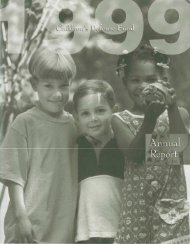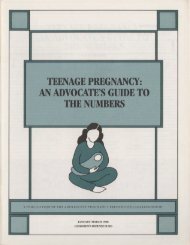child care - Digital Library Collections
child care - Digital Library Collections
child care - Digital Library Collections
You also want an ePaper? Increase the reach of your titles
YUMPU automatically turns print PDFs into web optimized ePapers that Google loves.
THE STATE OF AMERICA'S CHILDREN YEARBOOK ]998<br />
Table 1.1 Children In Poverty, 1996<br />
Number<br />
Characteristic (thousands) Percent<br />
Total 14,463 20.5%<br />
Race or ethnicity<br />
Hispanic a 4,237 40.3<br />
Black 4,519 39.9<br />
Asian or Pacific Islander 571 19.5<br />
White 9,044 16.3<br />
Place of residence<br />
CentraI city 6,509 30.8<br />
Rural (nonmetropolitan) 3,167 22.4<br />
area<br />
Suburb 4,787 13.5<br />
Region<br />
South 5,543 22.9<br />
West 3,842 22.9<br />
Northeast 2,489 19.2<br />
Midwest 2,590 15.5<br />
Family type b<br />
Female-headed 7,990 49.3<br />
Male-headed 779 22.8<br />
Married couple 5,035 10.1<br />
Family employment status<br />
Family member works 9,471 14.7<br />
Part-time and/or part-year 5,793 51.9<br />
Full-time and year-round 3,678 6.9<br />
a. Persons of Hispanic arigin may be of any race.<br />
b. Data are for <strong>child</strong>ren related ta the head af hausehold by<br />
birth, marriage, or adoption.<br />
Source: U.S. Department of Commerce, Bureau of the Census.<br />
Calculations by Children's Defense Fund.<br />
Child Poverty: Pervasive<br />
and Persistent<br />
T:e overall numbers of <strong>child</strong>ren living in poverty<br />
are deplorable. Even more disturbing, the<br />
proportion of <strong>child</strong>ren in extreme poverty<br />
(that is, in households with an income less than<br />
half the federal poverty level, or less than about<br />
$6,250 for a family ofthree) actually grew from 8.5<br />
percent in 1995 to 9.0 percent in 1996, according<br />
to Census Bureau data. No racial group is immune:<br />
40.3 percent of Hispanic <strong>child</strong>ren, 39.9 percent of<br />
Black <strong>child</strong>ren, and 16.3 percent of White <strong>child</strong>ren<br />
were poor in 1996 (the first year that <strong>child</strong> poverty<br />
among Hispanics outpaced that among Blacks).<br />
And poverty afflicts <strong>child</strong>ren in every region of the<br />
country, in suburbs and rural areas as well as in the<br />
cities, and in households headed by couples and by<br />
single parents alike (see table 1.1).<br />
The workings of the economy alone will not<br />
eradicate <strong>child</strong> poverty. Although the nation was in<br />
its ftfth year of economic recovery in 1996, <strong>child</strong><br />
poverty crept down only to 20.5 percent, from 20.8<br />
percent in 1995. The proportion of poor <strong>child</strong>ren<br />
living in families where an adult worked at least<br />
some of the time soared to 69 percent in 1996, up<br />
from 61 percent just three years earlier. The average<br />
poor family with <strong>child</strong>ren in 1996 got more<br />
than twice as much income from work as from<br />
welfare (see figure 1.3).<br />
Why Poverty Matters<br />
~<br />
ew<br />
CDF report, Poverty Matters, compiles<br />
findings from recent research confmning that<br />
hild poverty is associated with a host of ills.<br />
Notably, Jeanne Brooks-Gunn and Greg Duncan,<br />
who reviewed several new <strong>child</strong> poverty studies in<br />
their recent volume, Consequences of Growing Up<br />
Poor, concluded that <strong>child</strong>ren living in extreme or<br />
prolonged poverty tend to suffer disproportionately<br />
from conditions such as stunted growth and<br />
lower test scores, and that poverty among preschool<br />
<strong>child</strong>ren is likely to have damaging effects<br />
on school completion many years later. Brooks<br />
Gunn, Duncan, and others report that poor <strong>child</strong>ren's<br />
worse odds in these areas appear to be<br />
linked to poverty itself and not merely to other<br />
family characteristics such as parental age, IQ, or<br />
marital status.<br />
As U.S. social welfare policy moves toward a<br />
work-based system, it is striking that a very strong<br />
economy has failed to prevent either an increasing<br />
proportion ofextremely poor <strong>child</strong>ren or more poverty<br />
among <strong>child</strong>ren younger than 6. Replacing<br />
welfare with below-poverty wages will not lessen a<br />
poor <strong>child</strong>'s likelihood of suffering from a serious<br />
disability, iron deficiency, or falling behind in<br />
4 CHILDREN'S DEFENSE FUND














